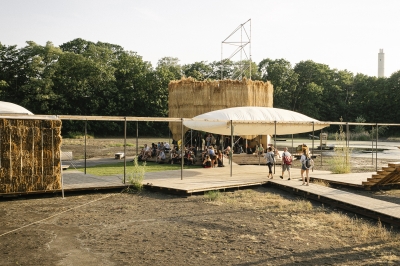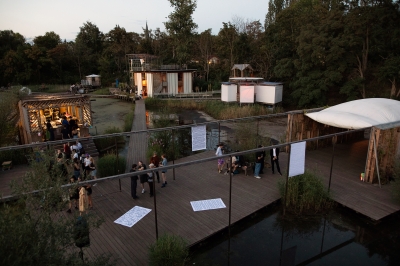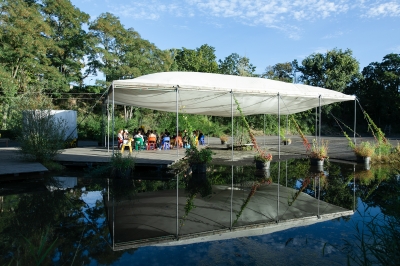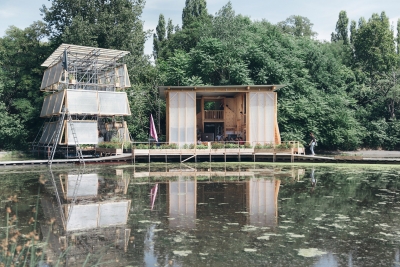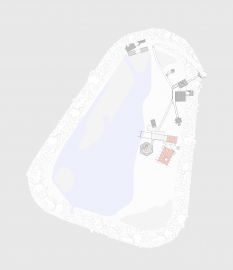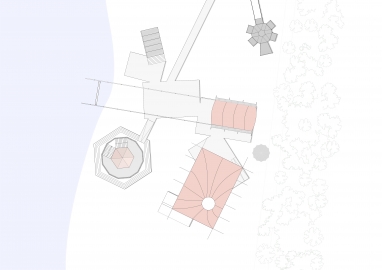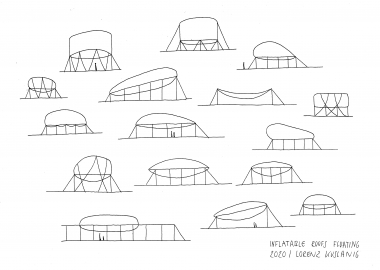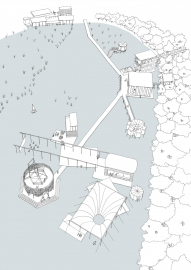Floating University Berlin
Floating University is a natureculture learning site. It is located in a polluted rainwater retention basin of the ex-Tempelhof Airport. The basin is simultaneously a working infrastructure of the city's water system and a home to wetland plants, birds, frogs, bats and foxes. Floating mission is to open, maintain, and take care of this unique site.
The rainwater basin receives the rainwater runoff from the former Tempelhof Airport and adjacent Columbia Damm Road since the 1930s. After nearly 100 years of being an epicentre of CO2 emissions and toxic runoff associated with air travel, Floating e.V. Association constructed an experimental cultural, pedagogical and social space inside the rainwater basin with low-impact materials and water filtration systems. As a site for architectural experimentation, the campus structures are deconstructed, redesigned, rebuilt every few years; currently they include an auditorium, multipurpose classrooms, workshop spaces, kitchen, greenhouse, and bar. Today Floating University offers a broad range of cultural, educational, discursive, all-ages programs around peoples' relationships with the city and the more-than-human world.
Floating University Berlin re-envisions an urban water infrastructure that invokes public participation. The architecture on site is constantly evolving: being built, deconstructed, and rebuilt. In summer 2020, after a series of workshops that collected spatial desires from association members, a “space task force” worked towards translating these wishes, as well as maintaining the existing infrastructure of the basin. In its design, the space group tried to take all relationships within the basin into account – talking with association members, observing trees and polluted water levels, discussing with political actors as well as neighbours, kids, grown-ups or nesting birds. The building process is collaborative.
Floating e.V's vision to transform the Tempelhof rainwater basin into an infiltration basin is a design for how to use nature-based solutions to filter the rainwater in the basin and make it possible to reuse to water local parks and graveyards affected by the drought and to infiltrate into the ground, rather than going unfiltered to pollute the Spree River like it has for the last 100 years.
Floating’s built structures include mostly reused materials and low-processed, biodegradable materials with small CO2 footprints, and a self-built water filtration system. The main structures are constructed with scaffolding, metal poles and beams. Wood is used to envelope the structures as well as for the various walking platforms. Inflatable roofs (some are also sliding) are made from fabric and have a ventilation and lighting system incorporated. Some walls are made with straw and the facade of the Rain Palace is made from reeds from the basin and from regional farmers; we plan to compost them and grow mushrooms on it. A milpa garden is the weight to prevent the kitchen from Floating. We use soil as weight that we plant vegetables on it so there is a reciprocal relationship between live matter and architecture.
Since Floating is a seasonal space, every winter the soft architectures need to be dismantled and stored to be reused/reinflated the next year. Each spring the space group and group of volunteers run the “Build+Care+Repair” programme where the structures are repaired, mended and re-installed.

